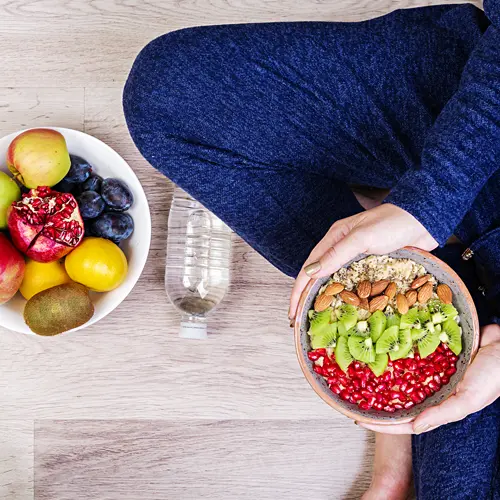Table of Contents
Creating a sustainable fitness routine is essential for achieving long-term health and wellness goals.
To develop a routine that you can stick to, it is important to focus on realistic and achievable goals, prioritize variety in your workouts, and listen to your body's needs.
Incorporating a mix of cardiovascular exercise, strength training, flexibility work, and rest days is key to promoting overall fitness and preventing burnout or injury.
Additionally, setting a consistent schedule, tracking your progress, and seeking support from a fitness community or a professional trainer can help you stay motivated and accountable.
By building a routine that is enjoyable, balanced, and adaptable to your lifestyle, you can establish healthy habits that will last a lifetime.
Set Realistic Goals
Set Realistic Goals: Creating a sustainable fitness routine starts with setting realistic goals.
When establishing your fitness goals, it is important to be specific, measurable, achievable, relevant, and time-bound (SMART goals).
Setting goals that are attainable within a realistic timeframe will help you stay motivated and track your progress effectively.
Consider factors such as your current fitness level, schedule, and any limitations you may have. Start by defining what you want to achieve with your fitness routine, whether it's improving endurance, building strength, losing weight, or simply staying active.
To ensure your goals are challenging yet achievable, break them down into smaller milestones.
This will allow you to celebrate achievements along the way and make adjustments if needed. Remember that progress takes time, so be patient with yourself and your body.
By setting realistic goals, you are more likely to stay committed to your fitness routine in the long run.
Find Activities You Enjoy
To create a sustainable fitness routine, it is essential to find activities that you genuinely enjoy. Engaging in activities that you find fun and fulfilling increases the likelihood of sticking to your fitness routine in the long term.
Here are some steps to help you identify and incorporate enjoyable activities into your fitness regimen:
- Reflect on Your Interests: Take some time to consider what types of physical activities you naturally gravitate towards. Whether it's dancing, hiking, cycling, swimming, or playing a sport, choose activities that resonate with you.
- Try Various Workouts: Experiment with different workout styles and classes to discover what you find most enjoyable. This could include yoga, Pilates, strength training, cardio kickboxing, or group fitness sessions.
- Outdoor Adventures: Embrace the outdoors by incorporating activities such as trail running, paddleboarding, kayaking, or rock climbing into your routine. Fresh air and natural surroundings can enhance your exercise experience.
- Socialize While Exercising: Join group fitness classes, running clubs, or sports teams to combine exercise with social interaction. Having a workout buddy or a supportive community can make training more enjoyable.
- Mind-Body Connection: Explore mind-body activities like yoga, tai chi, or meditation to promote holistic well-being.
These practices can help reduce stress, improve flexibility, and cultivate mindfulness. By finding activities that bring you joy and satisfaction, you can establish a sustainable fitness routine that aligns with your preferences and lifestyle.
Remember to listen to your body, set realistic goals, and stay consistent in your efforts to maintain a healthy and active lifestyle.
Mix Up Your Workouts
To create a sustainable fitness routine, one important strategy is to mix up your workouts regularly.
This not only prevents boredom and plateaus but also helps in targeting different muscle groups and keeping your body challenged.
There are several ways you can mix up your workouts:
- Incorporate a variety of exercises such as strength training, cardio, flexibility, and balance exercises.
- Try different workout styles like HIIT (High-Intensity Interval Training), Pilates, yoga, or swimming.
- Change the intensity, duration, and frequency of your workouts to keep your body adapting.
- Engage in outdoor activities like hiking, cycling, or running to add variety to your routine.
- Attend group classes or workout with a friend to add a social aspect to your fitness regimen.
By mixing up your workouts, you not only make exercising more enjoyable but also help your body become fitter and stronger in a balanced way.
Remember, the key to a sustainable fitness routine is to keep it engaging and challenging while listening to your body's needs and adjusting as necessary.
Listen to Your Body
To create a sustainable fitness routine, it is crucial to listen to your body. Paying attention to how your body responds to different exercises, intensities, and frequency is essential for long-term success in fitness.
By tuning in to your body, you can avoid injuries, prevent burnout, and make adjustments when needed. When you listen to your body during workouts, you can identify signs of fatigue, muscle soreness, or discomfort that may indicate you need to rest or modify your routine.
Pushing through pain or ignoring warning signs can lead to overtraining and setbacks in your fitness goals.
It's important to strike a balance between challenging yourself and allowing for proper recovery.
Additionally, by listening to your body outside of the gym, you can focus on adequate nutrition, hydration, and sleep to support your fitness journey.
Understanding your body's needs and respecting its limits will help you create a sustainable fitness routine that you can maintain in the long run.
By making adjustments based on how your body feels, you can progress safely and effectively towards your fitness goals.
Prioritize Recovery
To create a sustainable fitness routine, it is crucial to prioritize recovery. Recovery encompasses rest, proper nutrition, hydration, and strategic active recovery methods.
Here are some key tips to prioritize recovery in your fitness routine
- Schedule regular rest days to allow your body to recover and rebuild.
- Aim for 7-9 hours of quality sleep each night to support muscle recovery and overall well-being.
- Fuel your body with a balanced diet rich in lean proteins, whole grains, fruits, and vegetables to support recovery.
- Stay hydrated before, during, and after workouts to support muscle function and recovery.
- Incorporate light activities like yoga, stretching, or low-intensity walks on rest days to promote blood flow and reduce muscle soreness.
- Pay attention to signs of overtraining and adjust your training accordingly.
Stay Consistent
To create a sustainable fitness routine, staying consistent is crucial. Consistency is key to progress and seeing long-term results in your fitness journey.
Here are some tips to help you stay consistent:
- Set realistic goals: Define clear and achievable fitness goals for yourself. Break them down into smaller milestones to track your progress.
- Create a workout schedule: Plan your workouts in advance and allocate specific days and times for exercise. Treat these workout slots as non-negotiable appointments with yourself.
- Mix it up: Avoid monotony by incorporating a variety of exercises into your routine. This will keep your workouts interesting and prevent burnout.
- Listen to your body: Pay attention to how your body feels and adjust your routine as needed. Rest and recovery are just as important as exercise.
- Find a workout buddy or community: Having a support system can help keep you accountable and motivated. Join a fitness class or find a workout partner to keep you on track.
By following these tips and prioritizing consistency in your fitness routine, you can build healthy habits that will last a lifetime.
Track Your Progress
To create a sustainable fitness routine, tracking your progress is essential.
Keeping a record of your workouts, measurements, and overall performance can help you stay motivated and track your improvements over time.
There are several methods you can use to track your progress effectively. One way to track your progress is by maintaining a fitness journal or using a fitness tracking app.
You can record details such as the exercises you did, the sets and reps completed, the weight lifted, and how you felt before and after each workout.
This can help you identify patterns, set realistic goals, and make necessary adjustments to your routine. Another important aspect of tracking progress is monitoring your measurements and body composition.
You can keep track of your weight, body fat percentage, and measurements of key areas like waist, hips, chest, arms, and thighs.
This data can help you see changes in your body composition and track your physical transformation over time.
Additionally, tracking your performance in terms of strength, endurance, and flexibility is crucial. You can note down your progress in certain exercises, the duration of cardio sessions, and improvements in flexibility exercises like stretching or yoga poses.
This can give you a clear picture of your overall fitness level and help you set specific targets to work towards.
By actively tracking your progress in a structured manner, you can stay accountable, celebrate your achievements, and make informed decisions about your fitness routine.
Remember, progress looks different for everyone, so focus on your individual journey and work towards continuous improvement.
- Maintain a fitness journal or use a fitness tracking app to record workout details.
- Monitor measurements such as weight, body fat percentage, and key body areas.
- Track performance in terms of strength, endurance, and flexibility.
- Stay accountable, set realistic goals, and celebrate your achievements.
Adjust as Needed
To create a sustainable fitness routine, one of the key strategies is to adjust as needed.
This involves paying attention to your body's signals and progress, and making changes to your routine accordingly.
There are a few ways you can effectively adjust your fitness routine:
- Listen to Your Body: Pay attention to how your body responds to different types of exercise and intensity levels. If you're feeling constantly fatigued or sore, it might be a sign that you need to dial back the intensity or incorporate more rest days.
- Set Clear Goals: Having specific, measurable goals can help you track your progress and determine whether adjustments need to be made. Whether your goal is to build muscle, improve endurance, or lose weight, regularly reassessing your progress can guide you in adjusting your routine.
- Be Flexible: Your fitness routine should be adaptable to accommodate changes in your schedule, energy levels, or preferences. If you find yourself getting bored with your current routine, don't hesitate to try new activities or workouts to keep things fresh and engaging.
- Gradual Progression: When making adjustments, it's important to do so gradually to allow your body to adapt. Whether you're increasing the intensity, duration, or frequency of your workouts, gradual progression can minimize the risk of injury and burnout.
By staying attuned to your body's needs, setting clear goals, being flexible, and gradually progressing, you can create a sustainable fitness routine that evolves with you over time.
Remember that everyone's body is unique, so what works for one person may not work for another. Experiment, listen to your body, and make adjustments as needed to find a routine that works best for you.
FAQ
What factors should I consider when creating a sustainable fitness routine?
When creating a sustainable fitness routine, it's important to consider your current fitness level, goals, schedule, preferences, and any limitations you may have. By understanding these factors, you can tailor your routine to suit your needs and increase the likelihood of sticking with it long term.
How often should I exercise in a sustainable fitness routine?
The frequency of exercise in a sustainable fitness routine can vary depending on your goals and availability. Generally, aiming for at least 150 minutes of moderate-intensity aerobic activity or 75 minutes of vigorous-intensity activity per week, along with strength training exercises on two or more days, is recommended for adults.
What are some key components to include in a sustainable fitness routine?
A sustainable fitness routine should include a mix of cardiovascular exercise, strength training, flexibility work, and rest days. Variety in workouts, progression in intensity, proper form, adequate recovery, and listening to your body are essential components to ensure long-term success.
How can I stay motivated to maintain a sustainable fitness routine?
Staying motivated in a fitness routine requires setting realistic goals, tracking progress, finding enjoyment in exercise, mixing up workouts, seeking social support, rewarding yourself for achievements, and focusing on the benefits of regular physical activity, such as improved mood and energy levels.
How important is rest and recovery in a sustainable fitness routine?
Rest and recovery are crucial in a sustainable fitness routine as they allow your body to repair and adapt to the stress of exercise. Overtraining can lead to injuries, fatigue, and burnout, so incorporating rest days, proper sleep, and listening to your body's signals is vital for long-term sustainability.
What role does nutrition play in supporting a sustainable fitness routine?
Nutrition plays a significant role in supporting a sustainable fitness routine by providing the energy and nutrients your body needs to perform and recover from exercise. Eating a balanced diet rich in whole foods, staying hydrated, and timing meals around your workouts can enhance your fitness progress and overall well-being.
How can I adjust my fitness routine to prevent boredom and plateaus?
To prevent boredom and plateaus in your fitness routine, consider trying new activities, setting new challenges or goals, varying the intensity or duration of your workouts, incorporating group classes or outdoor workouts, working with a personal trainer, or exploring different fitness modalities to keep things interesting and stimulating.
What should I do if I experience setbacks or obstacles in maintaining a sustainable fitness routine?
If you experience setbacks or obstacles in maintaining a sustainable fitness routine, it's important to be kind to yourself, reassess your goals, seek support from a fitness professional or a healthcare provider, modify your routine as needed, prioritize self-care, and remind yourself of the reasons why you started your fitness journey in the first place. Remember that progress is not always linear, and setbacks can be valuable learning experiences to help you grow stronger and more resilient.




















